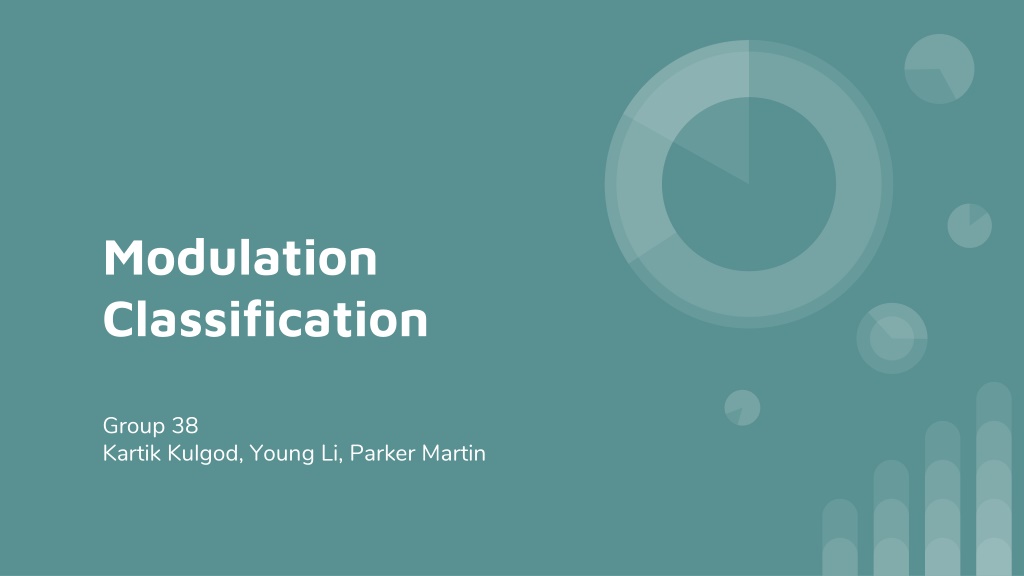
Advanced Modulation Classification Techniques
Explore the world of modulation classification, from the basics of modulation schemes like PSK and QAM to advanced techniques like Automatic Modulation Classification (AMC) using Machine Learning. Dive into literature surveys on Convolutional Radio Modulation Recognition Networks and Over-the-Air Deep Learning Based Radio Signal Classification, along with datasets like RadioML 2016.10A for model training and testing.
Download Presentation

Please find below an Image/Link to download the presentation.
The content on the website is provided AS IS for your information and personal use only. It may not be sold, licensed, or shared on other websites without obtaining consent from the author. If you encounter any issues during the download, it is possible that the publisher has removed the file from their server.
You are allowed to download the files provided on this website for personal or commercial use, subject to the condition that they are used lawfully. All files are the property of their respective owners.
The content on the website is provided AS IS for your information and personal use only. It may not be sold, licensed, or shared on other websites without obtaining consent from the author.
E N D
Presentation Transcript
Modulation Classification Group 38 Kartik Kulgod, Young Li, Parker Martin
Background One component of modem design in wireless communications is modulation Examples of modulation: Phase-shift keying (PSK) Continuous phase modulation (CPM) Quadrature amplitude modulation (QAM) Modulation is used to communicate digital information (0s and 1s) across an analog channel (amplitude and phase in I/Q plane) Different Modulation Schemes [5]
Background Modulator in Transmitter, Demodulator in Receiver Demodulator is specific to modulation scheme Cognitive Radios pick an optimal modulation scheme based on channel conditions (doppler spread, delay spread, use case) Could use brute-force to detect modulation scheme Better solution (SWaP) is to intelligently detect modulation scheme: Automatic Modulation Classification (AMC) Maybe ML can help! Example Delay/Doppler Profile [6]
Literature Survey Convolutional Radio Modulation Recognition Networks by O Shea et. al from 2016 Pioneers of AMC Used synthetic dataset Used CNN Architecture Roughly 87% accuracy across all Signal to Noise ratios (SNRs) Outperform other models especially in cases of low SNR and with short sample lengths Time-Series and Power Spectra of Each Modulation Scheme [1]
Literature Survey Over-the-Air Deep Learning Based Radio Signal Classification by O Shea et. al from 2018 Over the Air (OTA) signals from actual radios Much larger CNN architecture and Deep Learning (DL) approaches 24 modulation schemes Classification accuracies between 64%-80% Digital signal modulation classification with data augmentation using generative adversarial nets in cognitive radio networks by Tang et. al from 2018 Used auxiliary classifier generative adversarial networks (ACGANs) Showed superior performance compared with benchmark CNN network AlexNet Relative Model Performance of ACGAN compared with AlexNet [3]
Dataset The RadioML 2016.10A dataset will be used for training and testing the model 220000 data samples Consists of synthetic radio samples Samples collected over 20 SNRs from -20dB to 18dB 11 Modulation types: GFSK PAM4 WBFM CPFSK 8 PSK AM - SSB & AM-DSB QAM4, QAM16, QAM64 BPSK Example: {('8PSK',18):[[[ 4.2413832e-03 ... 3.0688841e-03][ 3.1789183e-03 ... 3 - 8.3045950e-03]] .... [[-3.8422775e-03 ... -1.2684792e-03][-1.9096208e-03 ... 2.7591861e- 03]]]}
Neural Network The neural network to identify the modulation type is a CNN First convolution layer: 2D Convolution Layer 1, 256 filters, kernel size is 1x3 2D Batch Normalization layer Second convolution layer: 2D Convolution Layer 2, 80 filters, kernel size is 2x3 2D Batch Normalization layer Sequential layer: Dense/Linear Layer 1, 256 output neurons Dense/Linear Layer 2, 11 output neurons Neural Network Architecture [2]
Neural Network ReLU activation was used between the Convolution layers and the Dense/Linear layers Final layer was the sigmoid layer to map between 0 and 1 Cross Entropy Loss was used as the loss function The optimizer used was Stochastic Gradient Descent The learning rate was 0.01 Batch size was 128 Test train split was 50:50 Neural Network was trained for 50 epochs
Observations and Results Negative SNR has high amount of noise Training model with -SNR data could hinder model effectiveness on +SNR inputs Improved model by using only +SNR data for training All of this was using the aforementioned hyperparameters Relative performance of model when omitting -SNR data from training Comparison of I/Q time-series between + 18 dB and +4 dB SNR
Observations and Results After all of that, before we began tuning hyperparameters, we tried to get a sense of how our neural net would do against a validation set. We noticed a clear sign of overfitting after only 10 epochs. Accuracy of our model Training vs Validation loss per epoch indicating overfitting
Observations and Results On the right, there is a graph that shows the classification accuracy relative to the evaluation SNR from O Shea, et al 2016. The paper achieves 87.4% accuracy. We achieve roughly 81% accuracy, but they used 50% and 60% dropout layers. Model Performance (Accuracy vs SNR) for CNN Models compared with benchmark alternatives [1]
Future Tasks Tune the hyperparameters of our neural net to get optimal performance and accuracy. Possibly either test adding dropout layers to deal with the overfitting or stop overtraining our model by doing less epochs. Create a confusion matrix to identify trends in misclassified modulations.
References [1] T. J. O Shea, J. Corgan, and T. C. Clancy, Convolutional radio modulation recognition networks, in International Conference on Engineering Applications of Neural Networks, Springer, 2016, pp. 213 226. [2] T. J. O Shea, T. Roy and T. C. Clancy, "Over-the-Air Deep Learning Based Radio Signal Classification," in IEEE Journal of Selected Topics in Signal Processing, vol. 12, no. 1, pp. 168-179, Feb. 2018. [3] B. Tang, Y. Tu, Z. Zhang, and Y. Lin, Digital signal modulation classification with data augmentation using generative adversarial nets in cognitive radio networks, IEEE Access, vol. 6, pp. 15713 15722, 2018. [4] Datasets. DeepSig Inc., www.deepsig.io/datasets. (Accessed 21 April 2020). [5] Transmitter Simulink Study, www.faculty.jacobs-university.de/jwallace/xwallace/courses/dsp/labs/01_sl_tx/. [6] Jean Paul Linnartz. Scatter Function. The Scatter Function, www.wirelesscommunication.nl/reference/chaptr03/fading/scatter.htm.
